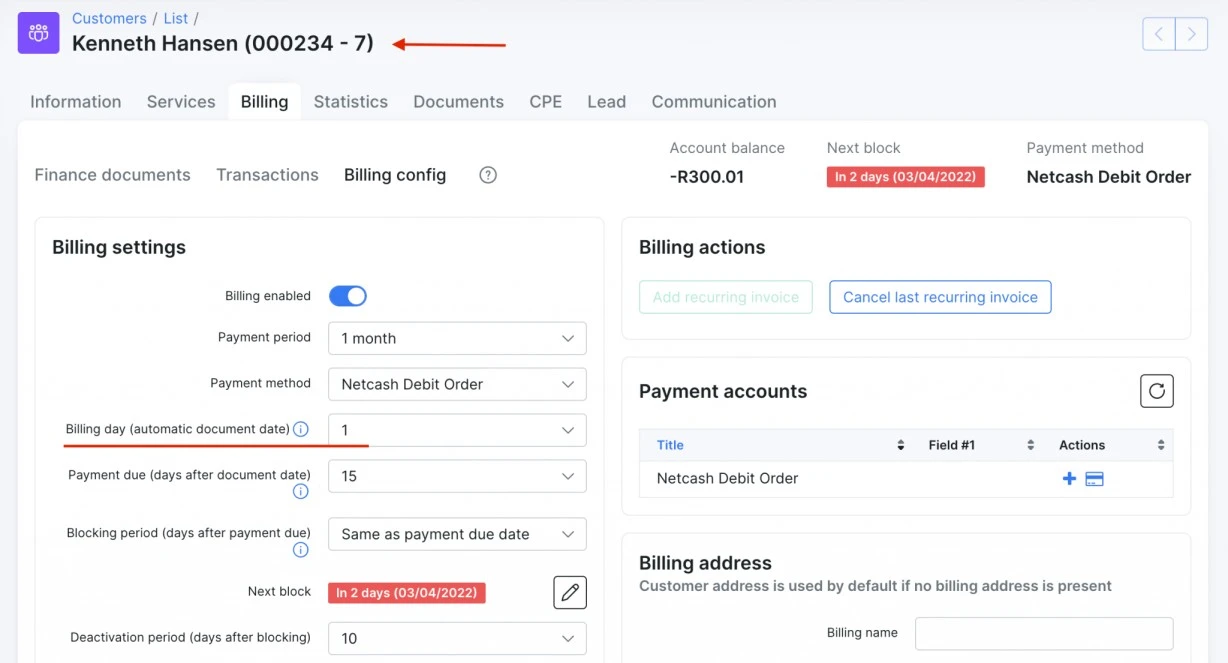



This article takes you through the process of streamlining how a recurring billing engine in Splynx can improve your customer billing process.
Recurring billing is a payment model that helps ISP businesses charge their customers for their services at regular time intervals: monthly, quarterly, annually, or even daily.
Recurring payments save time for internet service providers and customers as they simplify the customer’s experience and help them avoid missed payments. Automating payments also benefits a business by improving customer retention, making it easier to predict cash flow.
Based on the parameters you set in within the Splynx interface and integrations with major payment systems, the program helps streamline these operations minimizing human interaction.
Take the list of payment systems: “Payment systems”.
Though the recurring type of billing is selected by default in the Splynx global configuration, it’s up to you to decide which billing type works best for your business — recurring or strict prepay, which suggests that the customer pays when the service is accessed or consumed.
Charging your customers only for the period they used your services is relevant for subscription-based businesses. Splynx automatically prorates the invoice in case you bring on a new customer during the mid-pay cycle, upgrade or downgrade them, or change services in any way.
Simply put, the pro-rated amount is calculated:
In Splynx, issuing recurring invoices can be done in two ways:
There are different approaches to setting the billing date in Splynx:
If the customer switches between plans, it can be qualified as either upgrading or downgrading the subscription, depending upon the price difference between the two subscriptions. The good news about this is that Splynx automatically prorates the price, so you don’t have to crunch numbers.
We’ll take a step further and dig into different ways to set up recurring billing in Splynx. This is where you’re afforded plenty of elbow room when setting up the best billing scenario that suits your business model.
Say, you have a customer who signs up on February 5 for a subscription that renews on the 1st of every month. If it’s a monthly subscription, you should charge on a calendar month basis (the most common practice).

You can choose to have the billing cycle of a new plan start immediately when the customer signs up or on a future date. If you opt to begin the billing cycle immediately, the cycle will be based on the date the customer signed up.

When creating a new subscription in a plan, you can override the plan’s billing date and specify a different one. In other words, every client can have an individual subscription. Of course, this presents pro-ration issues the company must address if it allows customers to change the billing cycle. But with Splynx, proration is done automatically, so you don’t have to worry about this added layer of complexity.

For some companies, it’s a working scenario to send invoices before the billing day. This approach ensures that customers pay their invoices timely, and the due date starts from a billing day.

As an Internet Service Provider, it’s imperative that you’re vigilant in giving your clients an opportunity to choose a suitable payment method: credits card payments, cash payments, online payments, refill card payments, etc.
Splynx empowers your business with omnichannel payment collection. The benefit of it is that it allows extending your payment offers list and improving the service. Through the Splynx interface, you’re able to filter all customers and charge them according to the selected payment method.

Recently, we added templates to allow ISPs to automatically apply billing preferences based on their payment collection flow and the customer’s selected payment method (which requires the latest version + Billing Config Add-On).
Now, admins can quickly adjust billing dates, payment due periods, blocking rules, and other settings, including reminders, according to the customer’s chosen payment method. Whether making changes for a single customer or applying bulk updates across the platform, the process is fast and efficient.
Working with resellers, you can set up the reseller mode according to your business needs and configure custom billing settings for each partner.
Read more about reseller modes in this article: “How to manage internet resellers in Splynx”
Suppose the reseller wants to run their own billing cycle and send the invoices to end-users. In that case, an ISP wholesaler can create a reseller’s account in the Splynx billing system and allow the reseller to charge their end-users using their invoices in a reseller mode. It means that the reseller can also manage and sell individual tariff plans.
This article in the user guide describes how to set up the reseller add-on: “Agents and resellers”.
Though there are potential hiccups, this approach can help you avoid negative side effects from the missed payments. To make this work, you just need to set up an auto-charge filter and make sure that the customer’s credit card is saved in the ‘Customer Portal’. This filter also allows you to configure automatic debit order submissions.
In Splynx, you can set up an auto-charge filter to adjust this action for most scenarios. To do so:
 To learn more about configuring an auto-charge filter, navigate to the article in the user guide.
To learn more about configuring an auto-charge filter, navigate to the article in the user guide.
Watch this short demo and see how to set up recurring billing in Splynx.
Find out how Splynx helps ISPs grow
Learn more